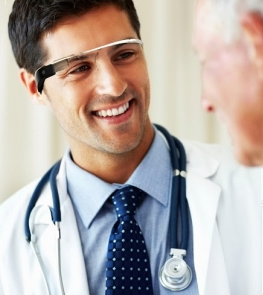Think the field of medicine is quickly advancing? Think again. It’s advancing much faster than you might be able to imagine. Pretty soon your doctor may be wearing Google glass the next time you visit him/her. Google glass is a wearable computer with an optical head mounted display. It displays information like a smart phone in a hands-free format.
One of the first places you may see the Google glass is in the operating room. Stanford University physician Dr. Homero Rivas has identified the potential of such technology and was introduced to augmented reality. In augmented reality, Google glass is able to superimpose an illustrated procedure step by step over the skin of the model.
With these models, doctors can “see” what they are cutting into and they no longer have to “guess” at where anything is. Once they better understand this, it will create less trauma and speed up recovery times. Dr. Rivas envisions that, “Soon, I’ll be able to implement all the algorithms from the MRI, send it to Glass, and then sit in front of the patient on the examining table. I’ll lay my eyes on the abdomen and see the hologram of the MRI to determine exactly where the mass is”.
Dr. Rivas thinks that one day we won’t even need cadavers or patients for medical students. They’ll be able to improve their medical procedures in the world of augmented reality.
In addition to augmented reality the Google glass may also be coming to general hospital floors near you. It is difficult enough keeping track of patient charts today. Even with the advent of electronic medical records today it still may not be enough. At Beth Israel Deaconess Medical Center in Boston, they are testing out Google glass for doctors when viewing charts. A patient will have a bar code or QR code assigned to them. These codes will correspond to vital signs, lab results, and any other pertinent information. Doctors can then look at the QR code and pull up the information while talking to the patient.
The Google glass has come a far way during their trial period in Boston. They are using external battery packs, improved wireless transmission, head tilt controls with scrolling, QR code app has been improved, and they are now even paired with clinical iPhones.
The medical field has been advancing very quickly and it’s no surprise that the medical industry has decided to adopt it. They are so many applications of these glasses that only time will tell how effective these novel ideas will become.

